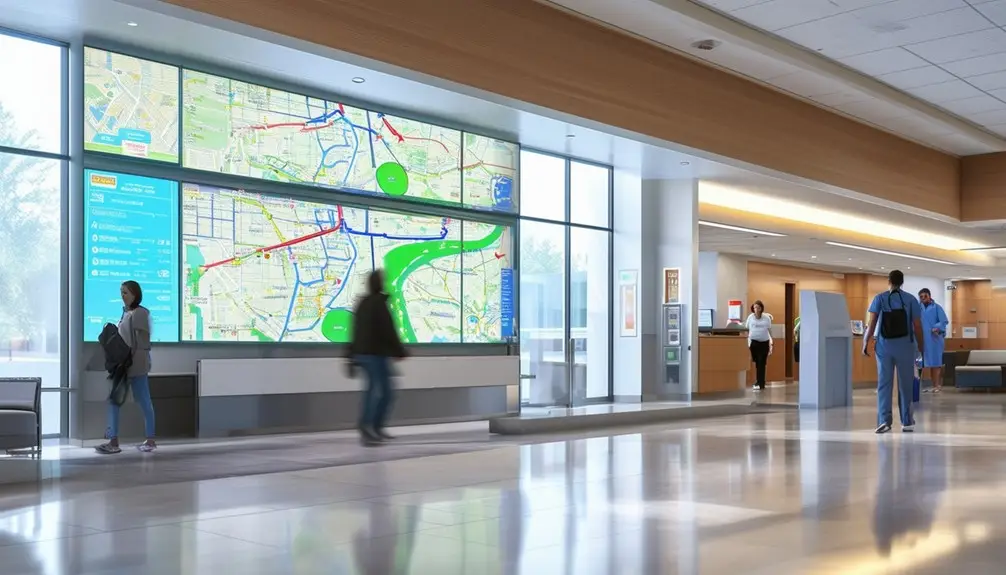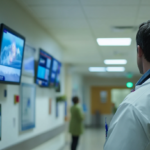You can optimize hospital navigation by leveraging digital signage systems that offer interactive maps and real-time updates. Use digital screens to input destinations and receive step-by-step instructions for the best routes, reducing confusion and stress for patients and visitors. These systems also enable personalized messaging, hospital information, and health education, all managed from a central platform. Unified content management guarantees consistent communication and branding across multiple locations, enhancing operational efficiency. Additionally, real-time emergency notifications guide individuals to safety with visual and audio cues. Explore further to discover how these features can transform patient experiences.
Key Takeaways
- Enhances patient navigation with interactive maps and real-time updates.
- Provides step-by-step directions to guide patients and visitors efficiently.
- Reduces confusion and stress by offering precise, customized routes.
- Utilizes digital screens for easy input of destinations and directions.
- Improves overall patient experience with clear, accessible navigation tools.
Flexible Wayfinding Solutions
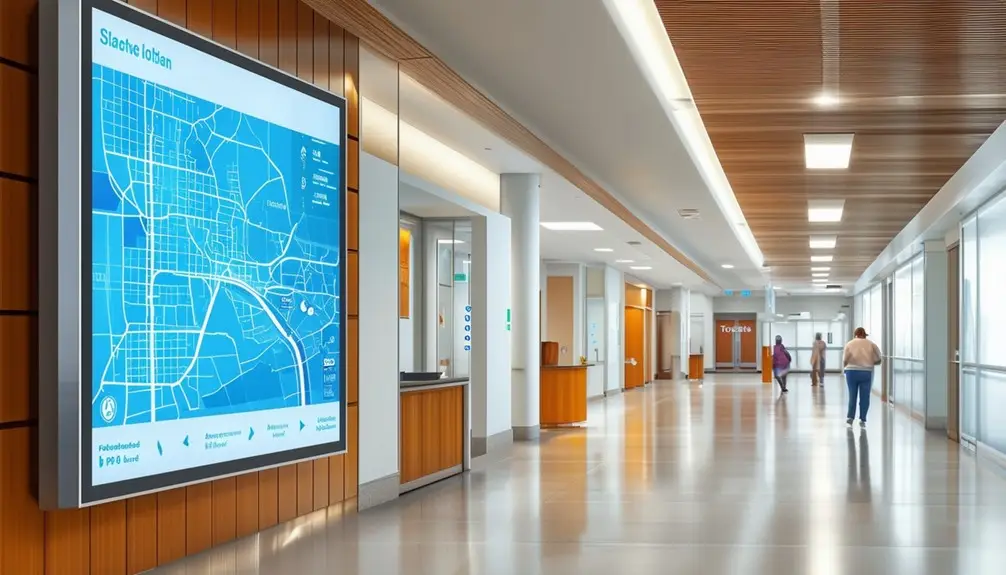
Implementing flexible wayfinding solutions in hospitals enhances patient navigation with interactive maps and real-time updates for precise directions. By utilizing digital screens, you can input destinations or scan QR codes to receive best routes and step-by-step instructions. This system fundamentally reduces confusion and stress among patients and visitors, as it offers clear, real-time updates and estimated travel times.
Interactive wayfinding not only streamlines the navigation process but also guarantees that ADA accessibility standards are maintained, promoting inclusivity within the healthcare environment. The digital screens strategically placed throughout the hospital provide a seamless experience by guiding individuals through various departments and facilities effortlessly.
These solutions are data-driven, meaning they adapt to the hospital’s layout and any ongoing changes, ensuring up-to-date information is always available. This adaptability is essential, especially in dynamic environments like hospitals where quick changes can occur. By leveraging the power of real-time updates, you can improve the overall navigation experience, making it a more efficient and stress-free process for all users.
Recognizing Staff and Donors
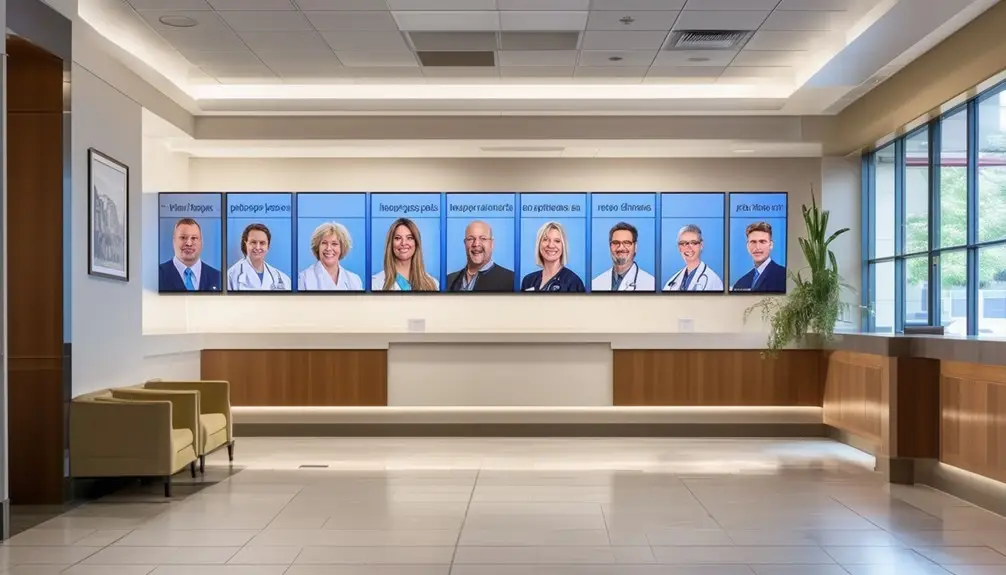
While enhancing patient navigation with flexible wayfinding solutions, it’s equally important to recognize the invaluable contributions of healthcare staff and donors through dynamic digital recognition walls. By leveraging digital signage for hospitals, you can create engaging video wall solutions that showcase the impact of donors and staff members in a visually stunning and efficient manner.
Digital recognition walls serve as a powerful tool for healthcare communication. They not only honor individuals and organizations but also foster a culture of gratitude and philanthropy. Utilizing interactive maps and digital signage, you can craft compelling narratives and testimonials that elevate the generosity of your contributors.
Consider these key benefits:
- Engage: Use immersive digital experiences to captivate and involve viewers.
- Acknowledge: Highlight the achievements and contributions of staff and donors.
- Inform: Provide real-time updates and relevant information through dynamic displays.
- Inspire: Encourage further donations and support by showcasing success stories.
- Unify: Create a cohesive and visually appealing recognition wall that aligns with your hospital’s branding.
Unified Content Management
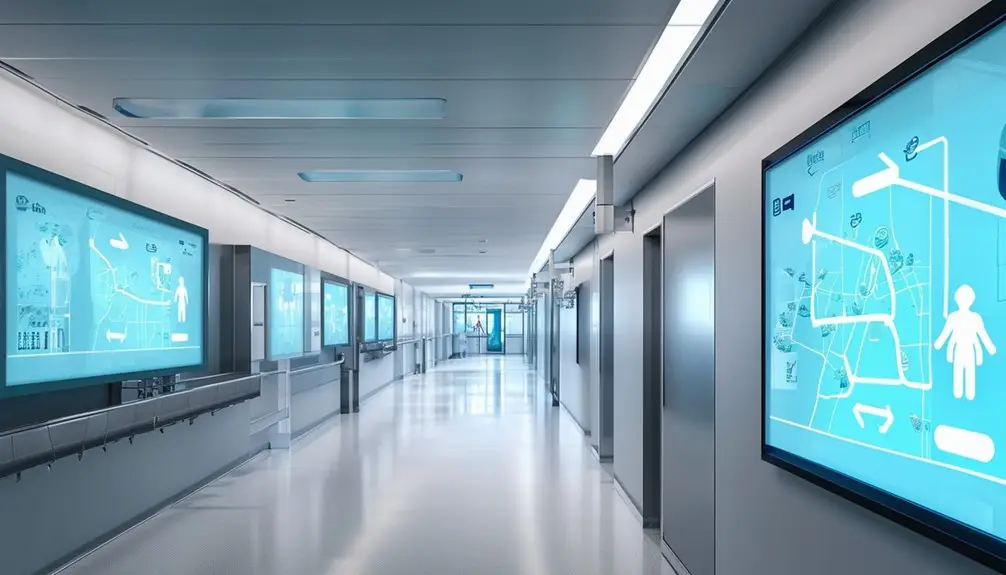
A unified content management system streamlines your hospital’s operations by consolidating multiple departments and locations under a single, efficient platform. With a unified CMS platform, you can manage and update your healthcare digital signage from a central location, ensuring consistent messaging and branding across all your hospital sites. This consolidation not only enhances operational efficiency but also upholds a cohesive brand identity, essential for patient trust and satisfaction.
By simplifying content management with a user-friendly interface, your staff can quickly and easily update digital signage with critical information, such as wayfinding, announcements, and emergency alerts. This reduces the time and effort required to maintain accurate and timely communication, ultimately enhancing patient experience and staff productivity.
A unified CMS platform facilitates seamless communication and information sharing between different hospital facilities. Whether you’re updating a schedule or broadcasting a new policy, the information reaches all relevant locations instantly and accurately.
Investing in a robust content management system is a strategic move to modernize your hospital’s infrastructure, improve operational efficiency, and provide a better overall experience for both patients and staff. Embrace the power of healthcare digital signage to stay ahead in a competitive environment.
Scalable Healthcare Solutions
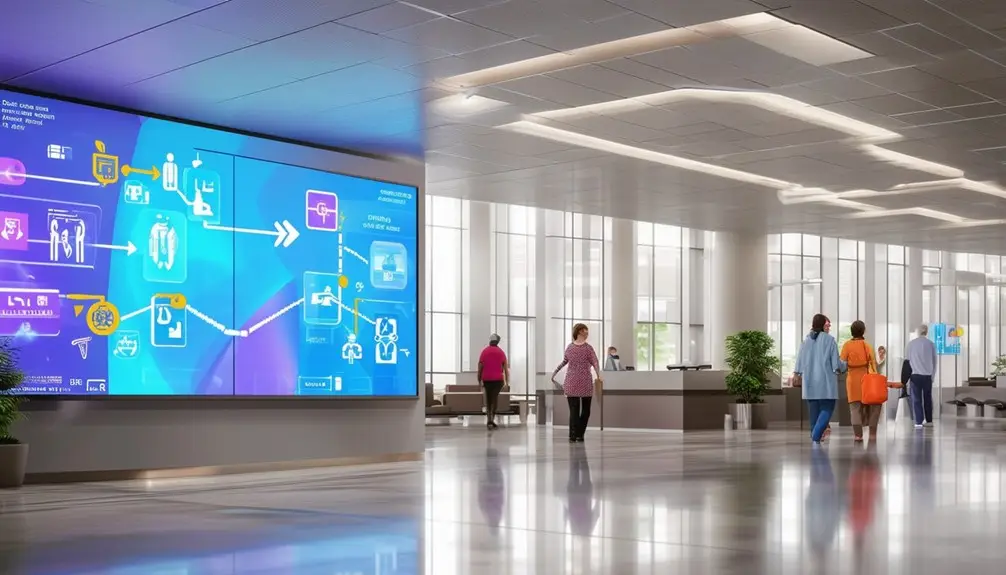
To implement scalable healthcare solutions, you need to leverage unified content management systems that streamline information distribution across digital signage. This enhances patient navigation by providing real-time updates and customized directions, reducing confusion and wait times. Integrating these systems guarantees a cohesive and efficient approach to managing hospital navigation and communication.
Unified Content Management
Implementing a unified content management system in healthcare facilities streamlines operations and guarantees consistent branding across multiple departments and locations. By integrating Digital Signage Software, hospitals can effortlessly manage and distribute content across various digital displays. Hospital digital signage has become more efficient and effective, making certain that the right information is accessible to patients, visitors, and staff at all times.
Using a unified CMS, you can:
- Simplify content updates: Instantly modify and broadcast new information across all digital signage screens from a central location.
- Maintain brand consistency: Guarantee that all messaging adheres to your hospital’s branding guidelines, irrespective of the department or location.
- Enhance operational efficiency: Reduce the time and resources spent on managing multiple content systems.
- Improve scalability: Easily add new displays or locations to the network as your facility grows, without overhauling the existing system.
- Centralize control: Monitor and manage all digital signage content from a single interface, providing a seamless management experience.
Utilizing a unified content management platform not only enhances your hospital’s brand identity but also offers a scalable solution that adapts to the ever-evolving needs of healthcare environments. This unified approach makes sure that your hospital’s digital signage operates smoothly and remains consistent, providing reliable information to everyone in the facility.
Enhanced Patient Navigation
Enhance patient navigation with scalable healthcare solutions like digital signage, which provides precise, real-time wayfinding assistance. By implementing digital signage, you can offer patients step-by-step instructions and estimated travel times, ensuring they reach their destinations efficiently. High-definition screens equipped with interactive maps display detailed floor plans and real-time updates, allowing for accurate and timely guidance.
Patients can input their desired destination or scan QR codes to receive the best route guidance directly on their mobile devices. This technology markedly reduces confusion and stress, contributing to an improved experience within the hospital environment. By offering clear and immediate directions, digital signage improves patient satisfaction and streamlines the overall navigation process.
Data-driven insights from digital signage systems can also help you identify and address common bottlenecks or areas of confusion within your facility. This information allows for continuous improvement and scalability, ensuring your healthcare solutions remain effective and adaptable as your hospital grows. Ultimately, investing in digital signage for patient navigation not only enhances the patient experience but also enhances operational efficiency, making it an invaluable tool in modern healthcare settings.
Digital Welcome Screens
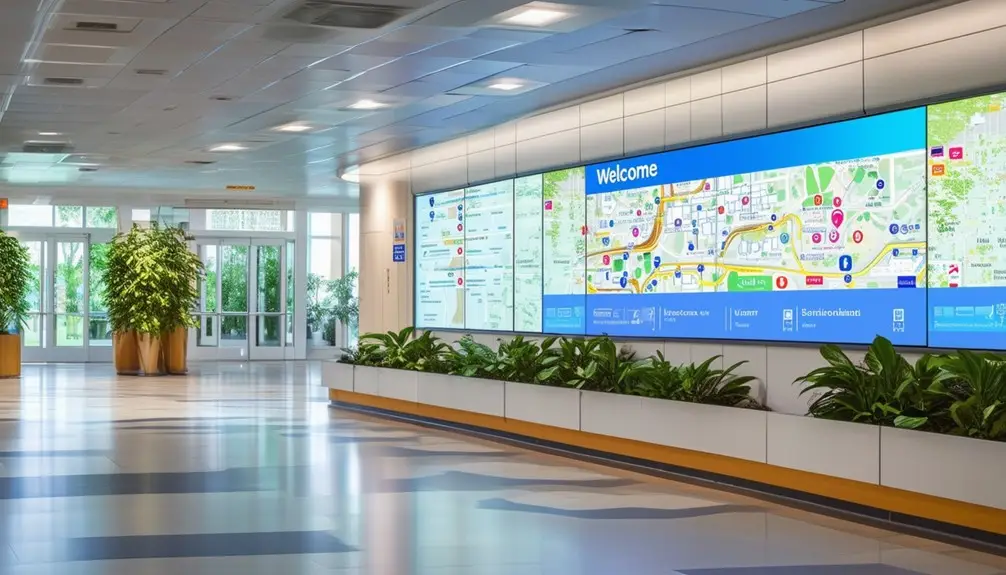
Digital welcome screens in hospitals provide personalized messages and critical information, creating a warm and inviting atmosphere for patients and visitors. These digital signage solutions are transforming the healthcare environment by enhancing the initial experience and building trust. Through dynamic content and engaging visuals, hospitals can showcase their achievements, upcoming events, and wellness programs, easing anxiety and making a memorable first impression.
Utilizing digital welcome screens offers several benefits:
- Personalized Messaging: Tailor content to greet patients by name, making them feel seen and valued.
- Hospital Information: Display directions, visiting hours, and facility maps to help visitors navigate more easily.
- Health Education: Share important health tips, medical notifications, and safety guidelines to keep everyone informed.
- Interactive Features: Allow users to interact with the screen for more detailed information, improving the overall experience.
- Announcements: Highlight critical updates and emergency information swiftly and efficiently.
Emergency Notifications
In pivotal moments, hospitals’ digital display systems deliver real-time emergency notifications that guide individuals to safety with visual and audio cues. These systems are essential for conveying crucial information during emergencies, guaranteeing that patients, visitors, and staff are promptly informed and directed. By integrating visual directions and cues, digital displays can efficiently guide individuals to safe locations, such as emergency exits or shelters.
Coupling visual cues with audio alarms significantly improves communication, especially in high-stress scenarios where prompt responses are vital. Real-time updates on the type and location of emergencies can be prominently displayed on a digital display, providing precise instructions that adapt as the situation evolves.
Implementing digital displays for emergency notifications in hospitals not only improves overall safety but also enhances preparedness. Data shows that clear, immediate communication can reduce panic and ensure orderly evacuations or responses. Hospitals can leverage these systems to display critical details like evacuation routes, emergency contact numbers, and specific instructions based on the emergency type.
Conclusion
By incorporating digital signage, hospitals can enhance navigation efficiency by up to 30%, according to recent studies. You’ll see improved wayfinding, streamlined content management, and scalable solutions tailored to your healthcare facility’s needs. Digital welcome screens and emergency notifications guarantee a safer, more welcoming environment for patients and visitors. Invest in these advanced technologies to recognize staff and donors effectively, making your hospital a model of modern, efficient healthcare.
Frequently Asked Questions
What Is Digital Wayfinding Signage?
Did you know 87% of hospital visitors find digital wayfinding signage reduces their navigation time? You’ll use interactive maps and QR codes to get step-by-step directions, enhancing your experience and minimizing stress in complex facilities.
How Do I Set up Digital Signage?
You set up digital signage by first analyzing high-traffic areas, then choosing the right hardware and software. Install displays strategically, create engaging content, and maintain the system regularly to guarantee accurate, up-to-date information for users.
What Do I Need for Digital Signage?
Imagine your screens as the heartbeat of your system. You’ll need high-definition displays, digital signage software, QR code scanning, real-time update capabilities, and detailed floor plans to guarantee efficient, accurate content management and navigation assistance.

